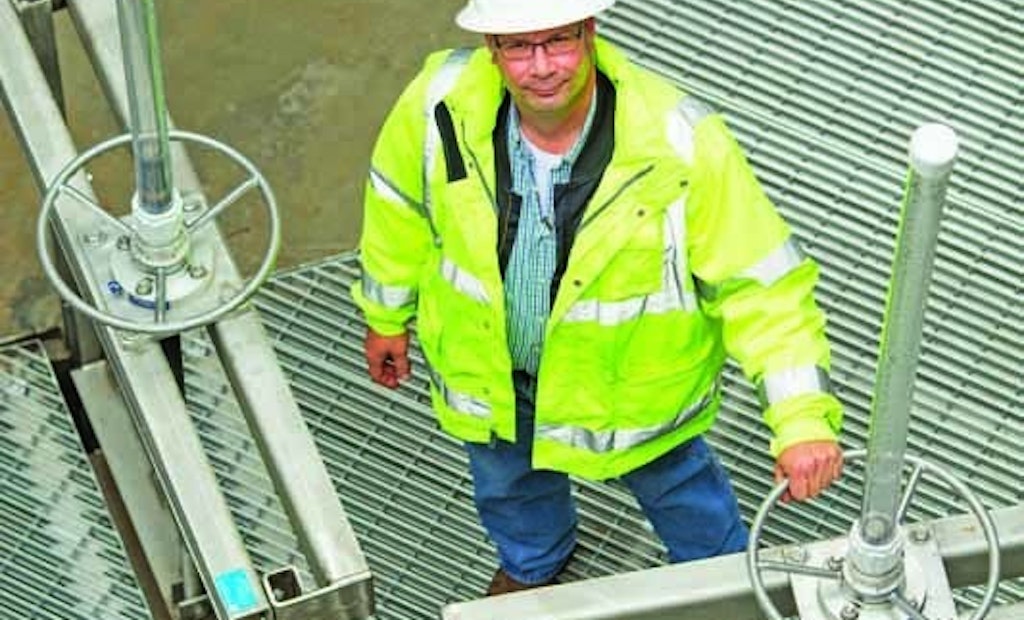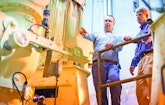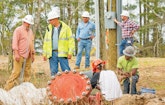
Interested in Cleaning?
Get Cleaning articles, news and videos right in your inbox! Sign up now.
Cleaning + Get AlertsGravity is inescapable, but it’s not always enough to convey wastewater.
The Cape Fear Public Utility Authority was formed in 2008 by merging the sewer and water systems of New Hanover County and Wilmington, North Carolina. Local terrain provides little relief, and the authority’s robust pump station crew is leading the charge to ensure that wastewater is effectively conveyed throughout the system.
Both systems had experienced sanitary sewer overflows prior to 2008 and were looking for efficiencies as they addressed a consent decree brought by the U.S. EPA. Among the county employees at the time of the merger was Bob Mazzeo, now pump station supervisor with CFPUA.
“Before the merger I was a pump station mechanic,” he says. “Our systems didn’t practice a lot of preventive maintenance and experienced a lot of failures. There were just two of us taking care of 111 pump stations, with no supervision other than the county engineer.”
Mazzeo was promoted to pump station foreman and then to supervisor in 2013. Today, he’s responsible for 142 pump stations that convey wastewater to two major treatment plants and one package plant.
“The territory is so flat that we have quite a few pump stations for our size geographically,” says Mazzeo. “We operate all different varieties, from submersible to flooded suction, suction lift and self-priming.”
Mazzeo has built a dedicated team of five pump station crews, each consisting of a pump station foreman, a mechanic and an operator. Two electricians cover the entire system — one focusing on generator service and another on the telemetry and SCADA systems.
Fix it yourself
The utility also operates a pump station repair and refurbishing shop.
“We have the capability of rebuilding pumps and fabricating parts that need replacement,” says Mazzeo. “When a pump is taken out of service we replace it and get to work on the old unit. We have the capability of rewinding motors, refurbishing gearboxes and repacking bearings. If we can’t refurbish it, we’ll scavenge it for reusable parts.”
The city and county utility culture prior to the formation of the CFPUA involved siloed responsibilities.
“Everyone was doing their own thing and a lot of effort was devoted to putting fires out,” Mazzeo says. “Since the formation of the authority, my crew’s responsibilities have extended to anything where the pressurized lines convey wastewater. We’ll work on release valves, isolation valves, manhole inspections, system rehab, new construction or pump station installs.”
Pump station crew members are all expected to be proficient in basic plumbing and mechanics. They all receive electrical training, allowing them to deal with a wide range of emergency repairs.
The pump station crew will also work with the right-of-way crew and the 11-person sewer maintenance and inspection crew, which operates five combination trucks, including Vac-Cons and Vactors. The force mains are inspected annually and the entire system is cleaned every three to five years. Air release valves are checked annually.
Everyone on the truck
“If one of the pressurized mains is ruptured, we’ll assist repair crews with the Vactor, either pumping or helping to engineer a bypass,” Mazzeo says. “When there’s a fire, everyone gets on the firetruck. We try to do as much as we can without hiring outside contractors.”
Pump cleaning represents the bulk of preventive maintenance. The common enemies of pump operation include sand infiltration from the flat coastal area and typical fats, oils and greases; flushable rags; and hygiene and medical products.
Crews visit each pump site weekly and check flowmeters, then enter data into the IBM Maximo workflow system. Runtimes and electrical usage are tracked, then compared against average electrical consumption and runtimes. Unusual activity may indicate anything from a clogged or overworked pump to a broken or jammed impeller.
“The crews get to the pumps and take them out of the hole if they’re submersible,” Mazzeo says. “For heavier pump units we use a boom truck. The crew members check the valves, tear them apart and open the inspection ports and clean them out. They put in new wastebaskets and then take the trash bags to the landfill. Over the years, we’ve noticed that the quality of the pump build is improving, especially the impellers, which are more robust and move material better.”
The generator lifeline
About 80 percent of the pumps are paired with fixed backup generators. Another 20 portable generators are standby units, moved into place during weather emergencies.
“Electricity might be shut off because of anything from a hurricane to a car crashing into a utility pole,” Mazzeo says. “All of the generators are run under load for an hour each month. If we spot any problems in a generator, in the control cabinets or in the telemetry systems, they’re serviced by our in-house generator specialist.”
Foremen and mechanics carry smartphones to photograph maintenance work and components. These photographs are later attached to work orders.
“Even if you’re taking something apart, it’s a good idea to photograph it so you can put it back together properly,” Mazzeo says. “We have photos going back for years.”
The utility is ISO 14001-certified for environmental management. Although pump station standard operating procedures are written out, Mazzeo gives crew members the leeway to use their own judgment.
“If something is broken, there may be 10 different ways to fix it,” he says. “If SOPs are too strict, there’s no leeway for a better solution, so if a foreman has a better idea we encourage them to modify or update that procedure.”
Working with engineers
Mazzeo also works closely with engineers and system designers (see sidebar) from the earliest stage of design.
“We determine what suits the utility best, from specifying a building or a hut, the placement of tank floats, to whether we use a gantry crane or a service truck to lift the pump,” says Mazzeo. “We inspect at various stages of construction and do final inspection when the station is being commissioned.”
In recent years, the pump station crew has shifted its efforts from reacting to emergencies to preventive maintenance.
“We’re now devoting 60 percent of our time to preventive maintenance,” Mazzeo says. “Overtime has been cut in half and after-hour emergency calls are way down.”
The system continues to expand. Four pump stations are currently under construction and a fifth is being upgraded.
“With new development, the total buildout for the CFPUA will probably require upwards of 500 pump stations,” says Mazzeo. “I’ll be retired when they hit 500, but the system that I hand over to my successor will be in very good shape.”
The shadow of success
There’s nothing like walking in the shoes of another person through their workday to learn more about what they do. A unique job-shadowing exercise at the Cape Fear Public Utility Authority paired Carter Hubard, a consulting engineer with design firm WK Dickson & Co., and Bob Mazzeo, pump station supervisor with CFPUA.
WK Dickson has been contracted by CFPUA to supply design services for anything from water treatment plants to sewer collections infrastructure, water wells and pump stations.
Hubard was alerted to the opportunity to build a presentation around a job-shadowing exercise by office staff members who had been working with representatives of the North Carolina American Water Works Association & North Carolina Water Environment Association and CFPUA.
“They wanted an operations focus to develop a closer bond between consultants and operations staff,” says Hubard. “I had worked with Bob on pump station design, rehab and upgrades and he agreed to the idea. Bob has a passion for his job. He’s the kind of guy who likes to get involved in everything on the ground level. I’ve seen him jump on a CCTV truck where they were having trouble and not leaving until he fixed the equipment.”
Mazzeo and Hubard spent a day together, building on a working relationship that backed up paper designs with real world experience.
“Carter understands the difference between taking delivery of a pump station with that new car smell and actually operating it,” Mazzeo says. “By working together during the design phase, we can adjust things that might never be thought of — something as simple as the way a line comes into a wet well is important. You put a line in too high and the water drops and creates bubbles. The pump sucks up the bubbles and creates cavitation.”
Location of pump controls is also critical. The pump station crew prefers controls to be located adjacent to access ladders.
“That way you won’t have to set up scaffolding to get to it,” says Mazzeo. “There’s no reason to operate like a Cub Scout if you don’t have to.”
Hubard notes that the exercise helped him appreciate the needs of the pump station crew.
“You never do a standard pump station design for them,” he says. “They are always looking for ways to improve things and make them both cost-effective and compliant.”
Visiting a recent pump installation, Hubard says crews pointed out that a cable protruding from the back of a panel was too rigid to bend around tight corners in the final installation.
“We reviewed the design and the next pump station will have the cable in a different location,” says Hubard. “As designers we recognize that everything is evolving and changing.
Working with the people who will be operating the equipment is a rewarding part of the design process.”









